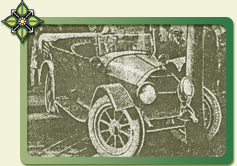THE WATCHER
Sir George Charles Thomas Steward (1865-1920)
With a military bearing, his moustache rampant a la Emperor Wilhelm and his air of hauteur, he was brusque and decisive in manner as in mind.

At 9.40 a.m. on 11 May 1920, a motorcyclist noticed a double-seated Cadillac driving erratically on St Kilda Road. Coming alongside he found the driver slumped over the wheel. He called out but the driver did not respond and the car veered off the road into a tree. Minutes later George Steward was dead from heart failure. Thus ended the extraordinary life of one of the most powerful public servants in Australia's history. And by all accounts Steward was not a man to cross. He used his power both for public good and for purposes less clear.
Steward's residence was in Alma Road, St Kilda at the time of death. He was commander of the St Kilda Regiment from 1915.
Steward had risen from humble beginnings to occupy an amazing array of positions of public influence. They ranged from right hand man to five governors-general, army commander, spymaster and commissioner of police. With federation in 1901 he became the chief clerk of the newly created Commonwealth Department of External Affairs.
Born the son of a laborer in London, Steward began his first job at 15 in the London Post Office. He later married Edith Jermyn the daughter of a fishmonger. After moving to Tasmania in 1892 he had a meteoric rise through the public service. His activities included railways, education, chief inspector of explosives, supervisor of totalisers, premier's secretary, town clerk of Hobart, and under-secretary for Tasmania. It was during this time that he divorced Edith and later married Anne Lucas Synot.
In 1901 Steward moved to the Commonwealth Department of External Affairs where he became official secretary to Lord Tennyson and four subsequent governors-general over a 17-year period. His responsibilities included the use of secret dispatches. In a foretaste of future unsavoury tasks, Steward conveyed, from Prime Minster Barton to Brisbane customs officers, the secret instructions for administering the immigration dictation test. These instructions guided customs officers to selectively apply the test to coloured applicants (The Outsider) effectively implementing the White Australia Policy until it was repealed in the 1950s.
Also shadowy was his intelligence role. In 1910 Steward founded and headed the counter-espionage bureau, Australia's first secret service whose agents pursued members of the International Workers of the World (Wobblies) and IRA activists. He also carried out secret political work for Prime Minister Hughes. One governor general nicknamed him 'Pickle the Spy'. His military positions included work in the Australian Intelligence Corps. Early in the First World War he was the conduit for secret communications between Britain and Australia.
Steward has been described as 'reliable and very efficient' but also as an 'exceedingly jealous and domineering character'. At the time of his death Steward was chief commissioner of police in Victoria. Popular with the force, he successfully instituted important reforms including training and improved conditions for the men.
At his funeral the cortege was led by a detachment of mounted troopers followed by the police band playing the "Dead March in Saul". This was followed by five hundred police officers, four abreast, senior staff, the hearse bearing Steward's cap and a coach of floral tributes. His grey charger with the boots reversed in the stirrups accompanied the procession to where thousands of people gathered near the gates of St Kilda Cemetery.
![]()


